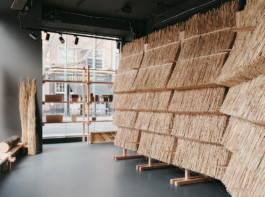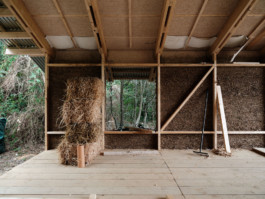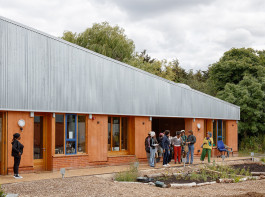Material Cultures is a not-for-profit design and research organisation working at the intersection of natural materials, low embodied carbon construction and construction technology. Our mission is to work towards a bio-regional construction industry which is integrated into regenerative and socially just land and building systems. We argue for the reintegration of architecture and agriculture, understanding buildings as irrevocably linked to landscapes of extraction. Bio-based materials are low in embodied carbon and offer an alternative to the globally sourced, carbon-intensive, socially destructive materials commonly used in the construction industry. We challenge the systems, technologies, processes, supply chains, regulations and materials that make up the construction industry with the aim of transforming the way we build.
Our practice works across different scales developing materials and prototypical buildings to look strategically at the adaptation of the landscapes and supply chains from which they emerge. We design buildings working to integrate bio-based materials and minimally processed minerals into efficient construction systems. Alongside this we carry out strategic research into how these ideas can be applied at scale and how they relate to a broader move towards regenerative land management practices. We run our own construction skills programme, MAKE, alongside research and teaching at the Architectural Association, Central St Martins in London and the ETH in Zurich.




Homegrown. See Project
Charleston in Lewes. See Project
Growing Place. See Project
Wolves Lane Centre. See Project
Selected Press
‘Bark is the original dampproof membrane!’ Meet the radical designers who let nothing go to waste
Oliver Wainwright
2025, The Guardian
Build Local!
Ellen Peirson
2025, The Architect's Newspaper
Material Cultures: the radical architects rethinking how – and what – we build
Mary Richardson
2025, Building Design
Material Cultures on transforming woodland waste into sustainable sheet materials
Derin Fadina
2025, The RIBA Journal
Material Cultures
Reuben J Brown
2024, The Architectural Review
Behind the scenes with a trio of architects pioneering sustainable materials
Malaika Byng
2024, House and Garden
Getting to the Root: Prototypes constructed using plant building materials
Lucia Gratz
2024, Werk, Bauen + Wohnen
In Search of Sustainable Materials, Architects are Turning to an Unusual Source: Hemp
Francesca Perry
2023, BBC
Selected Lectures
International Conference on Bioregional Architecture and Design Practice
Architecture on Stage: Material Cultures
Architecture Foundation with the Barbican
Material Cultures: Material Transformations
École D'architecture De La Ville & Des Territoires Paris-Est
2024, Paris
Symposium: On Tolerance and Transformation
HKU Department of Architecture
Selected Writing
2023, The Architectural Review
Material Cultures with Jess Gough
Material Cultures with Amica Dall
2022, Mack Books
Selected Books
Constructive Disobedience: An Experimental Methodology in Architecture
Ed. Matthias Ballestrem, Katharina Benjamin, Helga Blocksdorf
2025, Birkhauser
Manual of Biogenic House Sections
Ed. Paul Lewis, Marc Tsurumaki, David J. Lewis
2022, ORO Editions
Policies
As part of our mission to test and practice the possibilities of socio-ecological justice within architecture, we recognise that an essential part of this work is internal. The same harmful practices seen in the construction industry's supply chains – in land management, material streams and building systems – repeat themselves inside the studio in overwork culture, top-down management and opaque financial structures.
With support from peers and collaborators, we have been reviewing our internal processes to reflect the values we claim and to align better with our mission, as well as the demands of Section of Architectural Workers (SAW).
Current Team
Bo Yee Lau
Chai Pandya
Daria Moatazed-Keivani
George Massoud
Paloma Gormley
Rory Corr
Sally Moussawi
Summer Islam
Will Bradley
Collaborators
Amica Dall
Andi Amirshah
Becky Little
Cecence & Erthly
Ella Frost
Esme Walker
Ffion Blench
Henry Stringer
Jeffrey Hart
Jez Ralph
Mark Harrington
Mhamad Safa
Sara Pereira
Sandra Salazar D’eca
Rachael Milliner
Villalba Studio
Will Stanwix
Work Ltd
Past Team
Alastair Howard
Alessandra de Mitri
Amaya Hernandez
Aya Mousa
Caroline Esclapez
Caitlin McNamara
Ceri Hedderwick Turner
Christopher Kokarev
Christopher Gabe
Connie Beauchamp
Cosmin Chirpac
Eloise Coleman
Francesca Leibowitz
Francesca Tattersall
Joy Mulandi
Ker Jia Goh
Louise Underhill
Margit Kraft
Marwa El Mubark
Nana Adu-Offeh
Riyam Salim
Sam Little
Sara Sherif
Shreya Sarin
Sodueari Graham-Douglas
Tom Hart
William Hayter
Xiao Fang
Clients
Argent
Arup
The Architectural Association
The Bartlett School of Architecture, UCL
Bauhaus Earth
Building Centre
Central Saint Martins, UAL
Charleston House
CIVIC SQUARE
Create London
The Design Museum
Evolving Forests
Fishtank
Grizedale Arts
Forestry England
HG Matthews
Hong Kong Design Institute
Human Nature
International Architecture Biennale Rotterdam
London Metropolitan University
The London School of Architecture
Naked House
Newham London Borough Council
re:arc Institute
Stiftung Sitterwerk
SOM Foundation
Timisoara Architecture Biennial
V&A Museum
York & North Yorkshire Local Enterprise Partnership
Woods into Management Fund
Wolves Lane Consortium
Material Cultures is a not-for-profit design and research organisation working at the intersection of natural materials, low embodied carbon construction and construction technology. Our mission is to work towards a bio-regional construction industry which is integrated into regenerative and socially just land and building systems. We argue for the reintegration of architecture and agriculture, understanding buildings as irrevocably linked to landscapes of extraction. Bio-based materials are low in embodied carbon and offer an alternative to the globally sourced, carbon-intensive, socially destructive materials commonly used in the construction industry. We challenge the systems, technologies, processes, supply chains, regulations and materials that make up the construction industry with the aim of transforming the way we build.
Our practice works across different scales developing materials and prototypical buildings to look strategically at the adaptation of the landscapes and supply chains from which they emerge. We design buildings working to integrate bio-based materials and minimally processed minerals into efficient construction systems. Alongside this we carry out strategic research into how these ideas can be applied at scale and how they relate to a broader move towards regenerative land management practices. We run our own construction skills programme, MAKE, alongside research and teaching at the Architectural Association, Central St Martins in London and the ETH in Zurich.




Homegrown. See Project
Charleston in Lewes. See Project
Growing Place. See Project
Wolves Lane Centre. See Project
Selected Press
‘Bark is the original dampproof membrane!’ Meet the radical designers who let nothing go to waste
Oliver Wainwright
2025, The Guardian
Build Local!
Ellen Peirson
2025, The Architect's Newspaper
Material Cultures: the radical architects rethinking how – and what – we build
Mary Richardson
2025, Building Design
Material Cultures on transforming woodland waste into sustainable sheet materials
Derin Fadina
2025, The RIBA Journal
Material Cultures
Reuben J Brown
2024, The Architectural Review
Behind the scenes with a trio of architects pioneering sustainable materials
Malaika Byng
2024, House and Garden
Getting to the Root: Prototypes constructed using plant building materials
Lucia Gratz
2024, Werk, Bauen + Wohnen
In Search of Sustainable Materials, Architects are Turning to an Unusual Source: Hemp
Francesca Perry
2023, BBC
As part of our mission to test and practice the possibilities of socio-ecological justice within architecture, we recognise that an essential part of this work is internal. The same harmful practices seen in the construction industry's supply chains – in land management, material streams and building systems – repeat themselves inside the studio in overwork culture, top-down management and opaque financial structures.
With support from peers and collaborators, we have been reviewing our internal processes to reflect the values we claim and to align better with our mission, as well as the demands of Section of Architectural Workers (SAW).
Current Team
Bo Yee Lau
Chai Pandya
Daria Moatazed-Keivani
George Massoud
Paloma Gormley
Rory Corr
Sally Moussawi
Summer Islam
Will Bradley
Collaborators
Amica Dall
Andi Amirshah
Becky Little
Cecence & Erthly
Ella Frost
Esme Walker
Ffion Blench
Henry Stringer
Jeffrey Hart
Jez Ralph
Mark Harrington
Mhamad Safa
Sara Pereira
Sandra Salazar D’eca
Rachael Milliner
Villalba Studio
Will Stanwix
Work Ltd
Clients
Argent
Arup
The Architectural Association
The Bartlett School of Architecture, UCL
Bauhaus Earth
Building Centre
Central Saint Martins, UAL
Charleston House
CIVIC SQUARE
Create London
The Design Museum
Evolving Forests
Fishtank
Grizedale Arts
Forestry England
HG Matthews
Hong Kong Design Institute
Human Nature
International Architecture Biennale Rotterdam
London Metropolitan University
The London School of Architecture
Naked House
Newham London Borough Council
re:arc Institute
Stiftung Sitterwerk
SOM Foundation
Timisoara Architecture Biennial
V&A Museum
York & North Yorkshire Local Enterprise Partnership
Woods into Management Fund
Wolves Lane Consortium